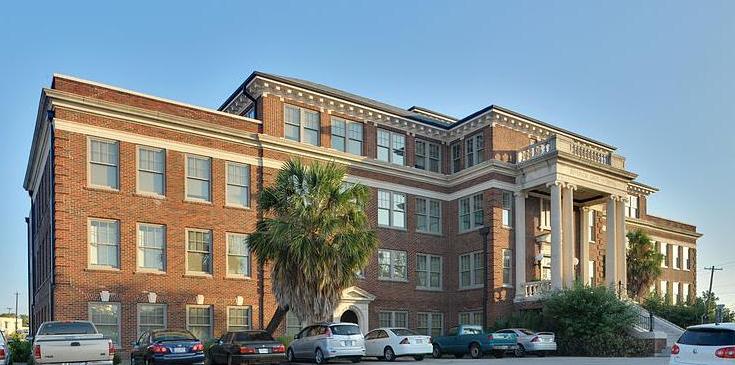 Artspace’s Elder Street Lofts in Houston — the former Jefferson Davis Hospital
Artspace’s Elder Street Lofts in Houston — the former Jefferson Davis Hospital
One of the reasons starving artists are starving is that they have to spend their food money on rent. But help may be on the way as a national nonprofit developer is working with the City of Dallas to create affordable housing specifically designed for artists.
Audio Player
In Erik Glissman’s workshop, he makes everything from furniture to public art pieces. He shares the work space with two other people.
It’s about 10 miles from the house he shares with three roommates. And it would be nice, he says, if home and work were closer together.
GLISSMAN: “It may be 9 o’clock at night where I have an idea that I’d like to go out in the shop to start working on. And that’s obviously not necessarily financially feasible for me just to take off and drive across town to come open up the shop and work for 10-15 minutes and then go back home.”
Many artists face similar situations. Glissman has another job to make ends meet. And finding housing he can afford, in an area where he wants to live, that’s near functional studio space is nearly impossible.
But a solution may be on the way. That’s because a non-profit developer is working with the City of Dallas to create an affordable housing project designed for artists.
 The company, Artspace, develops properties that include both living and studio space for artists. They feature elements that artists look for: high ceilings, extra wide doorways and large windows. (Left, the lobby of Artspace’s National Hotel Artist Lofts in Galveston.)
The company, Artspace, develops properties that include both living and studio space for artists. They feature elements that artists look for: high ceilings, extra wide doorways and large windows. (Left, the lobby of Artspace’s National Hotel Artist Lofts in Galveston.)
Wendy Holmes is the head of consulting and strategic partnerships at Artspace.
HOLMES: “Fifteen years ago, when we were just starting to do more work nationally, Dallas was on the radar in terms of artists needing space and finding themselves priced out of various neighborhoods.”
In September, Artspace and city officials will study what local artists are looking for in housing and work space, and whether there’s enough demand for this project. Then, if the project continues, they’ll look at buildings that could be redeveloped. They’ll also put together funding.
Money for Artspace projects usually comes from many sources, including low income housing tax credits, community development block grants, tax increment financing and philanthropy.
Those varied funding sources help keep rents low. For example, a 1,000 square foot apartment in Minneapolis, where Artspace is based, would typically go for $1,250 to $1,800 a month. But Artspace rents comparable places there for $500 to $700.
Zad Roumaya is a Dallas developer who helped link Artspaces with the city. Before becoming a developer, he lived commission-to-commission for five years as a sculptor.
ROUMAYA: “As a former working artist experiencing those highs and lows, I just thought, ‘What a perfect fit for a city not only of this size, but just the attitude of how we support the arts at so many layers.’ … The security of an artist’s mind – when they have a long term security in a space that a) is affordable but b) is designed well and prompts creative thinking – that actually juices their creative process that much more.”
Glissman says that there is also a cumulative benefit to being around other artists
GLISSMAN: “The kind of work I do, you’re constantly running into different problems and things you couldn’t foresee. And it’s really nice to have people from different perspectives be able to come in and help you problem-solve sometimes.”
Artspace has completed 30 projects since it was founded in 1979. Eleven more such spaces are in development around the country. The process is designed so that when construction finally begins, all of the funding is in place and a potential clientele has been identified.
Artspace’s model is what initially interested Karl Zavitkovsky. He’s the director of the city’s office of economic development.
ZAVITKOVSKY: “It’s like any good developer – they aren’t going to get way far out on their skis so to speak. They’re not going to get engaged with something until they find the right building, they understand the costs and how those costs are going to be met.”
The whole process typically takes three to five years. The developers and the city say the effort is worth it for what artists contribute to the culture. Glissman is working on a public art piece for Fort Worth Avenue. And he’s also the executive director of Art Conspiracy, an annual fundraiser for nonprofit arts programs. Plus, once a neighborhood gets an artist-friendly reputation, Roumaya says it becomes a target for additional development.
ROUMAYA: “When the commercial artists, photographers, graphic designers, fine artists start showing up – that is one of the first indicators that developers watch.”
The downside for artists is that can mean skyrocketing rents. But Artspace’s Wendy Holmes says that wouldn’t happen.
HOLMES: “We don’t sell our buildings, we don’t look for opportunities to play in the open market. We’re looking for the longest terms of affordability so that artists will always be a healthy part of a growing community.”
Image outfront from Shutterstock





15 Comments